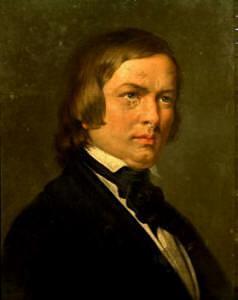Robert Schumann's Symphonic Etudes
 (Note: While you are reading this, be sure to download the many different versions of this work with eMusic's free trial. You get 50 mp3s for free no matter what with no obligations.) A favorite choice for concert pianists' recitals seems to be Robert Schumann's Symphonic Etudes, Op. 13. It is well-suited for the concert hall containing virtuosic passages, expressive movements and a thrilling conclusion. Schumann's contributions to the Etude genre follow closely in the footsteps of Frederic Chopin and Franz Liszt. However, the etudes are based on a single theme. Schumann also called the work "Etudes in the form of variations." This contributes to the overall seamlessness of the etudes and helped to establish its presence in the concert halls. Schumann composed the Symphonic Etudes in 1834, but later revised the work in 1852. There were originally eighteen etudes in the set. Schumann felt that at this length and difficulty it would be too draining and demanding of the pianist and later cut the number down to twelve etudes. This made the work a little bit more agreeable to the pianist as well as the listener. When Johannes Brahms republished the etudes in the 1890s, he selected five additional etudes to add to the set. These are now frequently included in performances and recordings. The theme that the etudes are based on was composed by Baron von Fricken, the amateur musician father of Schumann's short-term fiancee Ernestine von Fricken. It is in the key of C Sharp Minor and is quite tragic in character. This moves into a dirgelike march for the first etude. The next etude is Andante and is in the style of a rolling nocturne. The next etude is an energectic Vivace composed of a staccato like texture. The fourth etude is Allegro Marcato and uses a canon form in octaves that starts out with the theme but digresses quickly. In the fifth, Scherzando etude, a key change is made to the key of E major. Following the fifth etude, the sixth etude is a study in syncopation. Like the fifth etude, the seventh etude shifts into E major with a crescendo and dazzling display of virtuosic writing. Next comes an intricately ornamented eighth etude. The ninth etude is marked Presto Possibile, which means as fast as possible, a daunting tempo for any budding pianist! It is scherzo-like and one of the most challenging of the set. The theme is barely present in this etude. The tenth etude has a light and airy demeanor. However, the eleventh etude, cast in G sharp minor, is very somber and brings the listener into the darkest depths. The listener is brought out of this dreariness by the 12th and final etude. This etude is in the key of D flat major. It strays from the main theme altogether. Instead, Schumann uses a theme from an opera by Heinrich Marschner. This Allegro Brillante etude brings the work to a thrilling conclusion with its dotted rhythms and optimistic jubilism. I highly recommend the recording by Vladimir Ashkenazy from the 7 CD set of Schumann's Works for Solo Piano on the Decca label. He includes the extra etudes that I had previously mentioned. Labels: Schumann |
Subscribe: +Yahoo | +Newsgator | +Bloglines | +Rojo | +Google | +Newsburst | +AOL | +MSN | +Blogroll
Translate: Español | Deutsche | Français | Italiano | Português




Comments on "Robert Schumann's Symphonic Etudes"
-
 Anonymous said ... (10:09 PM, July 15, 2006) :
Anonymous said ... (10:09 PM, July 15, 2006) :
-
 afghani chandbali earrings online said ... (1:04 AM, December 26, 2020) :
afghani chandbali earrings online said ... (1:04 AM, December 26, 2020) :
post a commentAshkenazy can play the notes, but if you want to hear what can come out of these etudes, find a recording by Claudio Arrau. It is an entirely different piece of music you will hear, and probably what Schumann intended.
The listener is brought out of this dreariness by the 12th and final etude. This etude is in the key of D flat major. It strays from the main theme altogether. Instead, Schumann uses a theme from an opera by Heinrich Marschner. This Allegro Brillante etude brings the work to a thrilling conclusion with its dotted rhythms and optimistic jubilism.